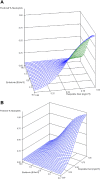An observational study of environmental exposures, airway cytology, and performance in racing thoroughbreds
- PMID: 30222207
- PMCID: PMC6189343
- DOI: 10.1111/jvim.15226
An observational study of environmental exposures, airway cytology, and performance in racing thoroughbreds
Abstract
Background: Mild equine asthma is presumed to arise in response to environmental exposures but the relative impact of differing inflammatory phenotypes upon performance are largely unexplored.
Hypotheses: Airway inflammation negatively affects performance and cytological phenotype varies with environmental exposure.
Animals: Thoroughbred racehorses in active training and racing.
Methods: Thoroughbreds were recruited 24-48 hours before racing. Each horse was eligible for re-enrollment with each race entry. Within one hour of race completion, physical examination, respiratory endoscopy, and BAL were performed. Respirable and inhalable dust, respirable endotoxin, and respirable β-glucan exposures were measured at the breathing zone within one week after racing. Controlling for age, trainer, and pulmonary hemorrhage, the relationship between performance, bronchoalveolar lavage fluid (BALF) cytology, and measures of exposure were modeled.
Results: Performance and BALF data were collected on 64 individual horses from 8 stables for a total of 98 race performances and 79 dust exposure assessments. Evidence of mild equine asthma was found in 80% (78/98) of BALF samples from 52/64 horses. For each percent increase in BALF mast cell and neutrophil proportions, speed figures were reduced by 2.9 (P = .012) and 1.4 (P = .046) points, respectively. Respirable dust concentration was associated with BALF neutrophil proportions (P = .015). Bronchoalveolar lavage fluid mast cell proportions were only associated with respirable β-glucan exposures (P = .030).
Conclusions and clinical importance: Mild equine asthma is common in racing horses and negatively impacts performance. The data support that respirable, rather than inhalable, dust exposure measures are pertinent to equine airway health.
Keywords: beta-glucan; bronchoalveolar lavage; dust; endotoxin; horse; parenchymal disease; pulmonary contusion/hemorrhage; respiratory tract.
© 2018 The Authors. Journal of Veterinary Internal Medicine published by Wiley Periodicals, Inc. on behalf of the American College of Veterinary Internal Medicine.
Figures








Similar articles
-
Environmental exposures and airway inflammation in young thoroughbred horses.J Vet Intern Med. 2014 May-Jun;28(3):918-24. doi: 10.1111/jvim.12333. Epub 2014 Mar 12. J Vet Intern Med. 2014. PMID: 24773603 Free PMC article.
-
The effect of lower airway inflammation on inflammatory cytokine gene expression in bronchoalveolar lavage fluid and whole blood in racing Thoroughbreds.Vet Immunol Immunopathol. 2021 Jul;237:110266. doi: 10.1016/j.vetimm.2021.110266. Epub 2021 May 9. Vet Immunol Immunopathol. 2021. PMID: 33991760
-
Dust exposure and pulmonary inflammation in Standardbred racehorses fed dry hay or haylage: A pilot study.Vet J. 2021 May;271:105654. doi: 10.1016/j.tvjl.2021.105654. Epub 2021 Mar 13. Vet J. 2021. PMID: 33840486
-
Airway Diagnostics: Bronchoalveolar Lavage, Tracheal Wash, and Pleural Fluid.Vet Clin North Am Equine Pract. 2020 Apr;36(1):87-103. doi: 10.1016/j.cveq.2019.12.006. Vet Clin North Am Equine Pract. 2020. PMID: 32145836 Review.
-
Bronchoalveolar lavage: sampling technique and guidelines for cytologic preparation and interpretation.Vet Clin North Am Equine Pract. 2008 Aug;24(2):423-35, vii-viii. doi: 10.1016/j.cveq.2008.04.003. Vet Clin North Am Equine Pract. 2008. PMID: 18652963 Review.
Cited by
-
Environmental Management of Equine Asthma.Animals (Basel). 2024 Jan 30;14(3):446. doi: 10.3390/ani14030446. Animals (Basel). 2024. PMID: 38338089 Free PMC article. Review.
-
A wearable real-time particulate monitor demonstrates that soaking hay reduces dust exposure.Equine Vet J. 2025 Jul;57(4):1065-1073. doi: 10.1111/evj.14425. Epub 2024 Oct 27. Equine Vet J. 2025. PMID: 39463012 Free PMC article.
-
Effects of low-dust forages on dust exposure, airway cytology, and plasma omega-3 concentrations in Thoroughbred racehorses: A randomized clinical trial.J Vet Intern Med. 2023 Jan;37(1):338-348. doi: 10.1111/jvim.16598. Epub 2022 Dec 7. J Vet Intern Med. 2023. PMID: 36478588 Free PMC article.
-
Horse Racing as a Model to Study the Relationship between Air Pollutants and Physical Performance.Animals (Basel). 2022 Apr 28;12(9):1139. doi: 10.3390/ani12091139. Animals (Basel). 2022. PMID: 35565565 Free PMC article.
-
Associations between Medical Disorders and Racing Outcomes in Poorly Performing Standardbred Trotter Racehorses: A Retrospective Study.Animals (Basel). 2023 Aug 9;13(16):2569. doi: 10.3390/ani13162569. Animals (Basel). 2023. PMID: 37627359 Free PMC article.
References
-
- Holcombe SJ, Robinson NE, Derksen FJ, et al. Effect of tracheal mucus and tracheal cytology on racing performance in Thoroughbred racehorses. Equine Vet J. 2006;38:300–304. - PubMed
-
- Beekman L, Tohver T, Leguillette R. Comparison of cytokine mRNA expression in the bronchoalveolar lavage fluid of horses with inflammatory airway disease and bronchoalveolar lavage mastocytosis or neutrophilia using REST software analysis. JVet Intern Med. 2012;26:153–161. - PubMed
-
- Lavoie JP, Cesarini C, Lavoie‐Lamoureux A, et al. Bronchoalveolar lavage fluid cytology and cytokine messenger ribonucleic Acid expression of racehorses with exercise intolerance and lower airway inflammation. JVet Intern Med. 2011;25:322–329. - PubMed
-
- Bedenice D, Mazan MR, Hoffman AM. Association between cough and cytology of bronchoalveolar lavage fluid and pulmonary function in horses diagnosed with inflammatory airway disease. JVet Intern Med. 2008;22:1022–1028. - PubMed
Publication types
MeSH terms
Grants and funding
LinkOut - more resources
Full Text Sources
Other Literature Sources

